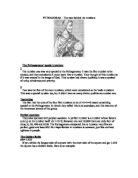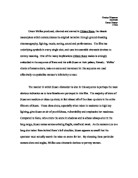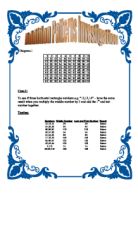Pythagoras - The man behind numbers
PYTHAGORAS - The man behind the numbers The Pythagoreans' special numbers The number one was very special to the Pythagoreans. It was the first number to be created, and they considered it much more than a number. They thought of this number as if it was created in the image of God. This number had divine qualities; it was a symbol of unity, wholeness and priority. 2 Two was the first of the even numbers, which were considered as the 'male numbers'. This was a special number too, but it didn't have as many divine qualities as number one. Teatraktos The fact that the sum of the four first numbers is ten (1+2+3+4) meant something special to the Pythagoreans. In Greek they called this sum teatraktos, and this was one of the innermost secrets of the group. Perfect numbers They also operated with perfect numbers. A perfect number is a number whose factors sum up to the number itself. (6: 1+2+3) Between one and 10,000 there are only four of these; 6, 28, 496 and 8128. The Pythagoreans compared this to humans: very few are perfect, good and beautiful. But imperfection in numbers is common, just like evil and ugliness in people. The Golden Ratio a/b= 1.618 If you divide the longest side of a square with the short side of the square and get 1.618 the square has a Golden Ratio. Here is an example: If you divide 3.2 cm with 2.0 cm you get 1.618. Therefore the square is
Orson Welles in Citizen Kane.
Kaeley Wiseman 0223360 Karen Kasner TY05 Orson Welles produced, directed and starred in Citizen Kane, the classic masterpiece which communicates its original narrative through ground-breaking cinematography, lighting, music, setting, sound and performances. The film has underlying symbols in every single shot, and uses innumerable cinematic devices to convey meaning. One of the many implications Citizen Kane makes is strongly embodied in the sequence of Kane and his wife Susan at their palace, Xanadu. Welles' choice of camera shots, mise-en-scene and movement in this sequence are used effectively to symbolize women's inferiority to men. The manner in which Susan Alexander is shot in this sequence is perhaps the most obvious indication as to how females are portrayed in this film. The majority of shots of Susan are medium or close-up shots; in fact almost all of the close-up shots in the entire film are of Susan. These close shots, especially when taken in moderate to high key lighting, give Susan an air of youthfulness, vulnerability and emphasize her meekness. Compared to Kane, who enters the scene in shadows and is almost always shot in the long-range, Susan comes across as being fragile, small and weak. As the camera cuts to a long shot taken from behind Kane's left shoulder, Susan appears so small that the spectator must actually search the mise-en-scene for
Maths Coursework – N Lines
n Maths Coursework - N Lines Please note that this coursework depends heavily on the graphics available in the attached word document. RULES To find out the regions it is: Lines + lines + closed regions (n+n= closed regions) To find out crossovers it is: Lines ? (lines - 1) 2 n? (n-1) 2 To find out open regions it is: Lines ? 2 (n?2) To find out closed regions it is: Region - open regions 3 lines 1 2 3 4 5 6 7 7 regions 6 open regions closed region 3 crossovers 5 lines 1 2 3 4 5 6 7 8 9 10 11 12 13 16 regions 10 open region 15 6 closed regions 10 crossovers 14 16 6 lines 1 2 3 4 5 6 7 8 9 10 13 14 1 12 16 17 18 19 20 regions 15 crossovers 12 open regions 10 closed regions 20 21 22 This is what I predicted 7 lines 2 3 4 5 6 11 13 14 10 15 7 8 9
Trimino Maths Coursework
Trimino Maths Coursework For this maths investigation, we had to investigate and patterns that we discovered involving the numbers used on a Truman and thereby deduce formulae to help us calculate unknowns. A trimino is similar to a domino yet has three side, as below. To begin with, I investigated the relationship between the highest number appearing on the trimino and the number of possible combinations. The table below shows the highest number o the trimino and the number of possible triminos. I began by taking the difference of the number of combinations, as shown above. As you can see, I had to take three differences before the differences were constant. This meant that the formula I wanted had to contain a cubic function. During my research prior to this investigation, I discovered the formula: ax3 + bx2 + cx + d = y I believed I could use this formula to help me discover a formula to link the highest number with the number of possible combinations. I applied to the results I achieved. My working is shown below: I substituted numbers into my formula to ensure it worked. My results matched those I had expected and therefore the formula I believe holds for all cases. After this, I moved on to try and link the number of combinations possible on a trimino to the previous one, thereby deriving an iterative formula. I again drew up a table of the highest number and the
To see if three horizontal rectangle numbers e.g. “12,13,14” – have the same result when you multiply the middle number by 2 and add the 1st and last number together.
Diagram.1 Case.1: To see if three horizontal rectangle numbers e.g. "12,13,14" - have the same result when you multiply the middle number by 2 and add the 1st and last number together. Testing: Conclusion: This happens because the mean of the 1st and last number is equal to the middle number i.e.: Mean of 12 and 14 = 13 Middle number = 13 The next part of the scenario was to multiply the middle number by 2 and plus the 1st and last number together; this is the same result - it can be proven when we write as it's shortest form i.e.: ( + ( = (2 ( ( 2= (2 Formula: Middle number multiplied by 2 = (First number) + (Last number) Case.2: To see if "Case.1" applies for horizontal and diagonal rectangles. Testing: Conclusion: The original formula (Case.1) also works for Variable.2. Case.3: Investigate what happens when Mary draws a rectangle around five numbers. Testing: I first tried to see if the formula for Case.1 applied for Case.3: Conclusion: The formula for Case.3 also works for rectangles with 5 squares whether it is diagonal, horizontal or vertical. Case.4 Investigate if the formula also works for any amount of rectangle squares: Testing: Conclusion: After doing the previous scenarios I have realised that by adding the first and last numbers together and then dividing by 2 makes the middle number (see formula in Case.4.) This works for any






